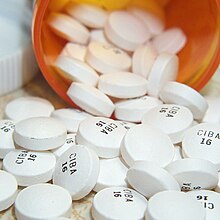Prescription Drug Marketing Act: Difference between revisions
No edit summary |
m Reverted edit(s) by 125.16.139.100 identified as test/vandalism using STiki |
||
| Line 9: | Line 9: | ||
| cite statutes at large=102 Stat. 95 |
| cite statutes at large=102 Stat. 95 |
||
| acts amended= |
| acts amended= |
||
| title |
| title amended= |
||
| sections created= |
| sections created= |
||
| sections amended= |
| sections amended= |
||
| Line 36: | Line 36: | ||
}} |
}} |
||
{{Regulation of therapeutic goods in the United States}} |
{{Regulation of therapeutic goods in the United States}} |
||
The '''Prescription Drug Marketing Act (PDMA)''' of 1987 (P.L. 100-293, 102 Stat. 95) is a law of the [[United States federal government]]. It establishes legal safeguards for [[prescription drug]] distribution to ensure safe and effective [[pharmaceuticals]]. It's designed to discourage the sale of [[counterfeit]], adulterated, misbranded, subpotent, and expired prescription [[drug]]s |
The '''Prescription Drug Marketing Act (PDMA)''' of 1987 (P.L. 100-293, 102 Stat. 95) is a law of the [[United States federal government]]. It establishes legal safeguards for [[prescription drug]] distribution to ensure safe and effective [[pharmaceuticals]]. It's designed to discourage the sale of [[counterfeit]], adulterated, misbranded, subpotent, and expired prescription [[drug]]s. It was passed in response to the development of a wholesale sub-market (known as the "diversion market") for prescription drugs. |
||
The PDMA was modified by the Prescription Drug Amendments of 1992 (P.L. 102-353, 106 Stat. 941) on August 26, 1992. |
|||
The U.S. Food and Drug Administration (FDA) issued regulations implementing the PDMA in 1990 (21 C.F.R. Part 205) and 1999 (21 C.F.R. Part 203). |
|||
== See also == |
|||
* [[Food and Drug Administration]] (FDA, USA) |
|||
* [[Good Distribution Practice]] |
|||
* [[Inverse benefit law]] |
|||
* [[Regulation of therapeutic goods]] |
|||
==External links== |
|||
*[http://www.fda.gov/oc/pdma/report2001/default.htm U.S. Food and Drug Administration's Report to Congress, June 2001] |
|||
*[http://www.globalcompliance.com/pdf/Prescription%20Drug%20Marketing%20Act%20(PDMA)%20Report%20to%20Congress.pdf U.S. Food and Drug Administration's Report to Congress, June 2001 (PDF)] |
|||
*[http://www.fda.gov/RegulatoryInformation/Legislation/FederalFoodDrugandCosmeticActFDCAct/SignificantAmendmentstotheFDCAct/PrescriptionDrugMarketingActof1987/default.htm PDMA article] |
|||
* [http://www.fda.gov/OHRMS/DOCKETS/98fr/06d-0226-gdl0003.pdf FDA page on PDMA law, regulations and guidance] |
|||
*[http://www.dhs.ca.gov/fdb/HTML/Drug/PDMA.htm California Department of Health Services Website, Food and Drug Branch page] (State agency provides background on federal PDMA) |
|||
[[Category:Marketing]] |
[[Category:Marketing]] |
||
Revision as of 02:55, 8 April 2012
 | |
| Acronyms (colloquial) | PDMA |
|---|---|
| Enacted by | the 100th United States Congress |
| Citations | |
| Public law | P.L. 100-293 |
| Statutes at Large | 102 Stat. 95 |
| Legislative history | |
| |
| Major amendments | |
| Prescription Drug Amendments of 1992 P.L. 102-353, 106 Stat. 941 | |
| Regulation of therapeutic goods in the United States |
|---|
 |
|
Prescription drugs Over-the-counter drugs |
The Prescription Drug Marketing Act (PDMA) of 1987 (P.L. 100-293, 102 Stat. 95) is a law of the United States federal government. It establishes legal safeguards for prescription drug distribution to ensure safe and effective pharmaceuticals. It's designed to discourage the sale of counterfeit, adulterated, misbranded, subpotent, and expired prescription drugs. It was passed in response to the development of a wholesale sub-market (known as the "diversion market") for prescription drugs.
The PDMA was modified by the Prescription Drug Amendments of 1992 (P.L. 102-353, 106 Stat. 941) on August 26, 1992.
The U.S. Food and Drug Administration (FDA) issued regulations implementing the PDMA in 1990 (21 C.F.R. Part 205) and 1999 (21 C.F.R. Part 203).
See also
- Food and Drug Administration (FDA, USA)
- Good Distribution Practice
- Inverse benefit law
- Regulation of therapeutic goods
External links
- U.S. Food and Drug Administration's Report to Congress, June 2001
- U.S. Food and Drug Administration's Report to Congress, June 2001 (PDF)
- PDMA article
- FDA page on PDMA law, regulations and guidance
- California Department of Health Services Website, Food and Drug Branch page (State agency provides background on federal PDMA)
